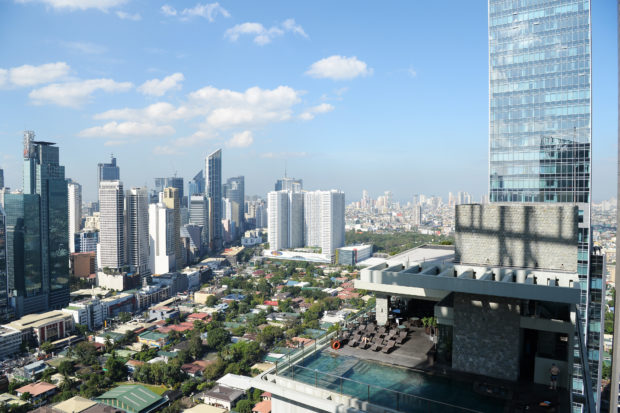MANILA, Philippines – The Philippines’ gross domestic product (GDP) likely slid by almost a fifth year-on-year during the second quarter at the height of the longest and most stringent coronavirus disease 2019 (COVID-19) lockdown in the region, London-based Capital Economics said.

This photo taken on January 29, 2019 shows a general view of the skyline of the financial district of Makati in Manila. (Photo by Ted ALJIBE / AFP)
Capital Economics senior Asia economist Gareth Leather told the Inquirer in an email last Friday that their projection showed the Philippines’ GDP shrank by 18 percent year-on-year, which he described as “one of the biggest in the region,” during the April to June quarter.
“Countries heavily dependent on tourism, such as Thailand, or which experienced long lockdowns like the Philippines, will have seen GDP fall 15-20 percent year-on-year last quarter,” Leather said in a July 24 report titled “Rupiah worries resurface, Korea’s ‘modest’ slowdown.”
In a webinar last week, Capital Economics’ global economists lumped together the Philippines, Thailand, Mexico, and Southern Europe among the economies which would most likely experience permanent loss of output from their respective domestic tourism sectors due to the pandemic.
For 2020, Capital Economics had forecast the Philippines’ GDP to shrink by 8 percent, in what could be the country’s biggest economic contraction in history.
The economic team was currently reviewing its earlier projection of 2-3.4 percent full-year GDP contraction after the country fell into a recession in the first half as the economy took a deeper-than-expected dive during the second quarter.
The government will release the official GDP figure on Aug. 6.
In a July 21 report, Barcelona-based FocusEconomics also further downgraded its 2020 GDP forecast for the Philippines to 3.9-percent contraction from 3.2 percent in June due to “a sharp recession in the second quarter.”
“Plunging remittances, evaporated tourism and foreign demand, a weak labor market and business closures in the wake of the pandemic are seen causing GDP to plunge this year, after eight years of growth above 6 percent. That said, a ramp-up in fiscal and monetary stimulus should cushion the downturn somewhat,” FocusEconomics said.
Last week, Acting Socioeconomic Planning Secretary Karl Kendrick T. Chua told CNBC that the proposed fiscal stimulus package or “Bayanihan 2” aimed at economic recovery was expected to be prioritized when Congress resumes session today, July 27.
“The [latest economic] numbers that we are seeing show quite a good sign of recovery,” said Chua, who heads the state planning agency National Economic and Development Authority (NEDA).
In a text message last Thursday, Chua pointed to improving tax collection, recovering purchasing managers’ index (PMI), among other economic indicators in June, which he said were already “trending towards 2019 levels.”
Last June, many parts of the country were placed under a less-restrictive general community quarantine (GCQ) status, which allowed 75 percent of the economy to operate, following about 2.5 months of a very stringent enhanced community quarantine (ECQ) which put a halt to three-fourths of economic activities.

